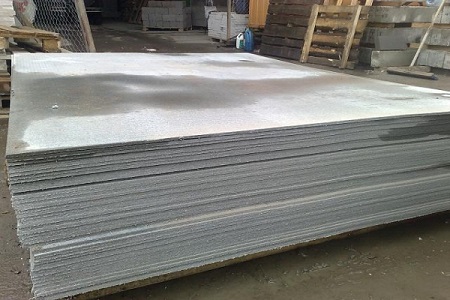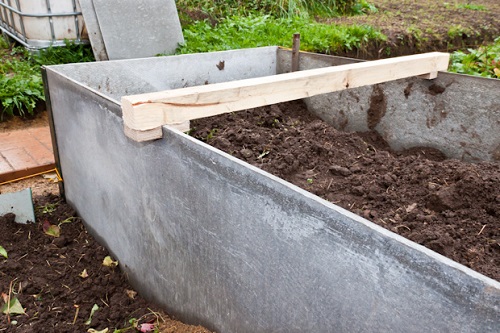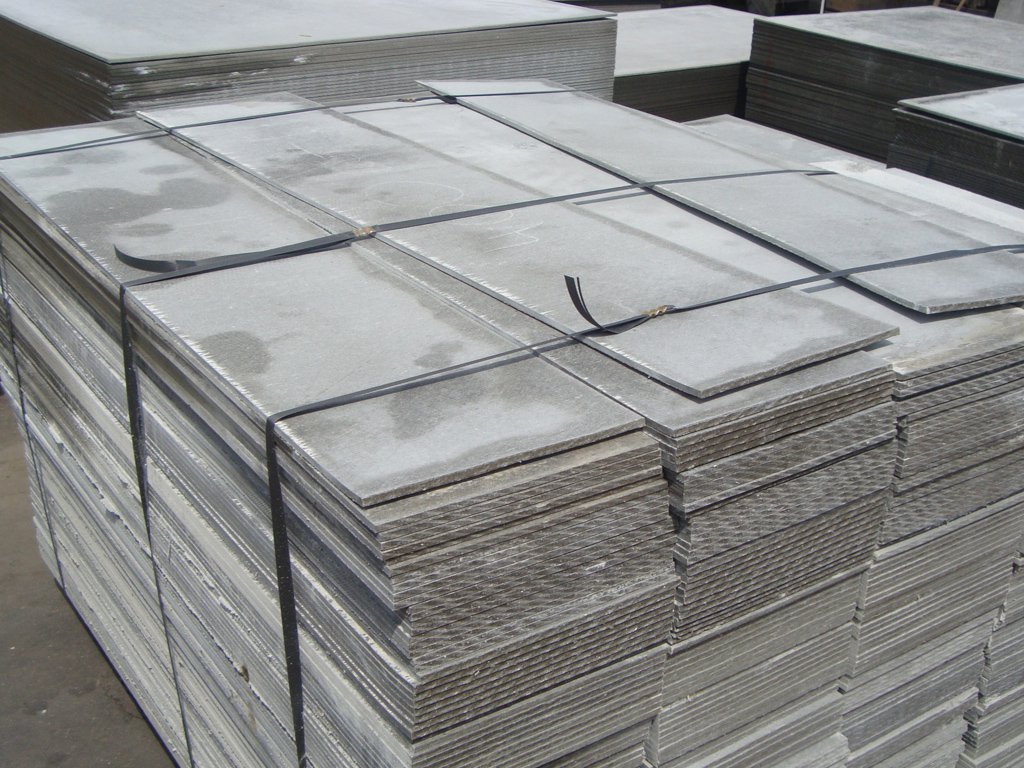Sheet slate is often used in the construction of residential buildings for roofing, as well as for the construction of fences, ceilings and other structures. From year to year, the need for this material is growing. Today they produce wavy and flat slates of different colors and structures.
Content
Composition and characteristics of flat slate
Flat slate (asbestos-cement sheet) is made from fine-fiber chrysolite asbestos and Portland cement. In the total volume, the fiber content is usually 8-10%, their main purpose is sheet reinforcement. One of the main characteristics of such a slate is weight. It depends on the thickness and size of the sheet.
Flat Slate Properties

The widespread use of this type of slate is determined by its operational qualities. It has large dimensions and is quite light, and this in turn allows you to quickly build all kinds of structures from it. Asbestos, which is part of a flat slate, determines its high fire resistance. Slate flat well tolerates temperature changes and climatic effects, and therefore it is actively used as a roofing material. Asbestos cement sheets are rather quiet material and during rain and hail in the house there will be no discomfort from excessive noise. In addition to the above advantages, the material is fragile and does not tolerate point loads.
Sheet Slate Categories
Types of Slate:
- asbestos slate;
- iron slate (based on steel with a slate wave profile);
- synthetic fiber bitumen sheets;
- polymer slate in the form of PVC sheets.
Bitumen-fibrous material is a modern alternative to the classic slate. It is based on fiberglass or treated cellulose. Well-known brands of such sheet material are euro slate and ondulin. According to the shape of the profile and the method of laying, it is not much different from the classic asbestos material. In comparison with it, bitumen sheets have the following properties: low weight, high strength. The light weight of such sheets allows them to be laid on top of the old material without the need to strengthen the rafter structure.
PVC sheets are becoming more common every year. Such slate is made by extrusion method with further shaping by vacuum forming. The advantages of PVC sheets include: light weight, durability, strength, a variety of colors, resistance to acids and alkalis.
Metal slate
This type of slate has gained its distribution due to the following indicators:
- manufacturability;
- ease of installation;
- excellent operational properties;
- durability;
- affordable cost.
Iron sheets are sufficient frost-resistant roofing material, which is highly resistant to mechanical damage. Its flexibility and lightness allow roofing work on complex roofs.
Asbestos sheets
Slate sheet in addition to density, frost resistance and other characteristics has certain standards. Pressed slate has the following properties:
- affordable cost;
- resistance to aggressive environment;
- soundproofing;
- the possibility of decorating;
- ease of installation.
Factory-made flat slate meets technological standards and will be carried out under the control of production processes.
Flat Slate Features:
- low labor costs for maintenance and repair of the roof;
- the price of slate is lower than tile or metal;
- not susceptible to corrosion;
- resistance to biocomponents;
- high frost resistance;
- low thermal conductivity;
- water tightness;
- strength;
- ease of machining;
- duration of operation;
- ease of installation and repair.
Flat Slate Production

Flat slate is made on special technological equipment. The entire manufacturing process consists of several stages - preparation of the mixture, molding, preliminary exposure, pressing, final exposure and finished products. Previously, flat slate was produced in the same gray color, but today there is a colored flat slate on the market, it is painted in different colors and has new consumer qualities.
Flat slate application
Slate flat is used for wall cladding, for interior and exterior decoration. Under it, you can lay insulation, but if you use color slate, in this case not only heat will be provided, but also the appearance. In the building itself, slate can be used as partitions. It is also actively used for the manufacture of floors. It is quite durable and in thickness can reach 40 mm. However, for this purpose it is better to use pressed flat slate, which can withstand a large load. It is also used in the manufacture of ventilation shafts, for fencing loggias and balconies. Traditionally, it is used for roofing.
Asbestos cement slabs can be used for the installation of sandwich wall panels. With the help of them equip aviaries, arbors, beds. Asbestos cement slab can be a good solution for laying paths, facing trade pavilions, country houses, cabins, etc.
Flat slate for beds
Each gardener knows how tedious it can be to plant beds in a summer cottage. This will require giving the beds the necessary shape and size, preparing the land, finishing the beds, etc. For gardening enthusiasts, the favorite type of beds are high slate beds.
Flat slate shows its best qualities here:
- the material is quite durable, since it does not rot, contacting with organic matter;
- flat slate application, which is very popular when creating beds, is ideal from an aesthetic point of view;
- The material is quite easy to use.
If we talk about the shortcomings of this material, then some believe that slate is not entirely favorable for soil quality. Many gardeners are sure that due to the properties of slate, the crop will be protected from the bear. For beds, a slate of classical wavy shape and flat can be used.

Before laying slate sheets must be prepared and checked for possible fragments, damage and cracks. If necessary, then the slate needs to be cut.
The construction of beds from flat and wavy slate sheets
You can arrange the beds using a color flat slate. It is laid like this:
- a slate sheet is 1.75 meters in length, and therefore, to avoid waste in work, it is recommended to divide the sheet in half. Accordingly, the same width will be in your beds.
- sheets of slate are fastened together using scraps of a metal corner.
- corners should be cut to size, drilled holes for bolts in them and subsequently painted over, protected from corrosion.

The beds laid by this method will be raised about 10 cm above the ground, and this, in turn, will improve the heating of the earth. The slate, which is deepened by 15-20 cm into the ground, will be real protection against penetration into the beds of roots. You can fasten slate sheets using other methods.You can use an aluminum corner and attach it to the slate using self-tapping screws.
To build beds from corrugated slate sheets is quite simple:
- using a grinder, pieces of slate of the required size are cut across the waves;
- a shallow trench is dug along the perimeter of the planned bed;
- chopped plates are installed in the trench;
- on each side, slate is sprinkled with soil, rammed for greater stability, if necessary, reinforced with metal pegs on both sides.

In order to avoid damage to the slate, it is necessary to prepare a trench for it first, and not drive it into the ground.
Simple secrets of beautiful beds
In order for your beds to be a decoration of the garden, you should follow a few simple rules. For a beautiful garden bed you need a suitable shape, color, size, which are selected at your own discretion.
Simple rules for creating beautiful beds:
- beds are located in the direction from east to west;
- the width of the beds should be up to 160 cm, and the height - up to 70 cm;
- beds require fencing, which can serve as a slate, deepened into the ground by 40 cm;
- the free space between the beds is sown with a lawn.
Compost is usually laid at the bottom of such beds, and then a layer of soil. For such beds you need to care, as well as for ordinary. They can be used for growing flowers, annual plants, because in them the soil freezes in winter as well as it warms up in summer.

Metal slate is quite susceptible to corrosion when used in alkaline and acidic environments. To protect this material, paints should be used.





Alas, no comments yet. Be the first!